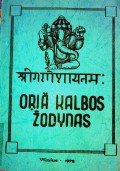
Type:
Žodynas
Language:
Oriya
Composers: Mironas, Ričardas
Published in:
Vilnius
Published on:
1972
Oriya (Oria or Odia) language dictionary (1972) compiler Ričardas Mironas (1908 – 1979) was a Lithuanian linguist, devoted philologist, translator and pedagogue. He could speak French very well, taught ancient Greek, Latin languages at the Department of Classical Philology at Vilnius University, also he was the only one who taught Sanskrit for a long time. India and its languages were the love of R. Mironas. He encouraged his students to develop interest in Sanskrit, and later in Hindi, in which he was self-educated.
Oriya, one of the 22 languages officially recognized in India, belongs to the Indo-Aryan branch of the Indo-European language family. It is considered to be a sister language of Bengali and Assamese and is mainly spoken in the state of Orissa. Of all the languages spoken in east India, Oriya is regarded as the one that has been the least influenced by Persian and Arabic. In contrast to Hindi, Oriya has preserved a lot of grammatical characteristics from Sanskrit: three genders, most of the declensions but only has two grammatical numbers. Contemporary Oriya was formed in the middle of 19th century, mostly thanks to Christian missionaries. The language is written in Oriyan script, originated from the Brahmi script family. The direction of writing is from left to right in horizontal lines.
This dictionary, compiled by R. Mironas, is one of a kind in Lithuania. You can find English – Oriya/Oriya – English translator on the Internet, but there is only one in Lithuanian. This dictionary of quite a small scope was typewritten and had a mission –“to add up a little to Lithuanians and Orissians’ friendship“. The foreword suggests that the dictionary is also intended for Indians. Besides, it contains a list of additional literature with reference to the books analysing the language and grammar. They are rather old. It is followed by a brief explanation of the alphabet and phonetic system – vowels, consonants and diphthongs. The first column of the pages of this dictionary presents Oriya words. In the second column you will find their translation into Lithuanian, in the third one – into Hindi, and the fourth column is their translation into Sanskrit (if applicable).
Most words in the dictionary have several synonymous meanings given. For example, there are more than two translations into Lithuanian or two in Sanskrit, which proves how abundant the Oriya language is. The dictionary is organized according to the Oriya alphabet. There are overall 3,474 words or compounds. The only thing that is missing yet would be very useful is the pronunciation.
